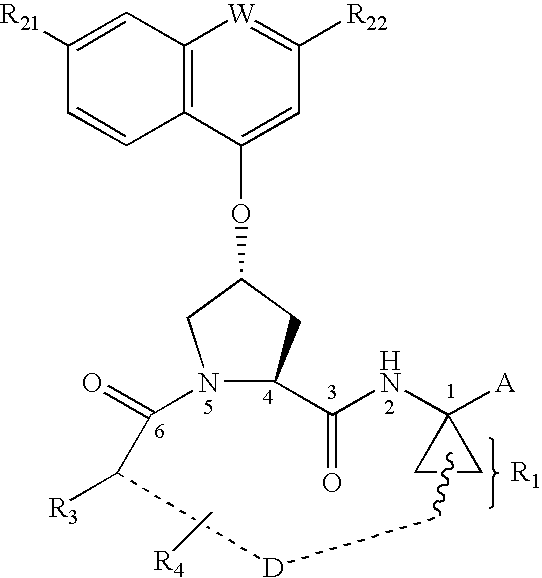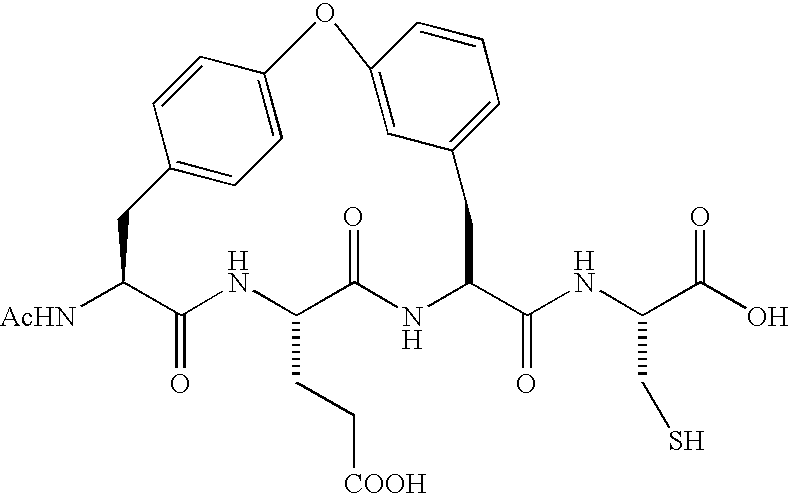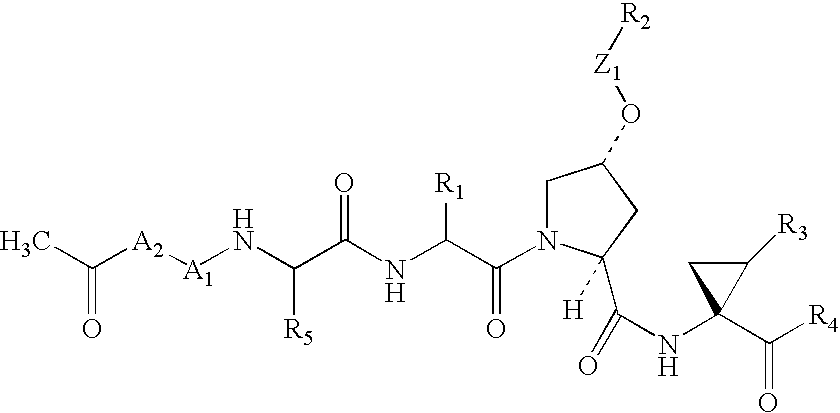Depeptidized inhibitors of hepatitis C virus NS3 protease
- Summary
- Abstract
- Description
- Claims
- Application Information
AI Technical Summary
Benefits of technology
Problems solved by technology
Method used
Image
Examples
example 1
Preparative
[0179]
Step A:
[0180] A solution of Boc protected compound 1a (Tsantrizos et al. U.S. Pat. No. 6,608,027 B1 (Boehringer Ingelheim, Canada), 2.2 g, 3.166 mmol) in HCl (4 M soln in dioxane 50 mL) and CH2Cl2 (50 mL) is stirred at rt. for 1 h and concentrated in vacuo. The disappearance of starting material is followed by TLC (acetone / hexanes 1:1). The gelatinous reaction mixture is concentrated in vacuo and dried to yield 1b that is used in next reaction without further purification.
Step B:
[0181] A solution of amide 1b (18 g, 64.67 mmol) in toluene (200 mL) is treated with BH3.DMS (2 M soln. in THF, 65 mL, 130 mmol) and heated at 80° C. for 3 h. The reaction mixture is cooled to rt and treated carefully with aq NaOH (2 M) and extracted into CH2Cl2 (3×200 mL). The combined organic layers were extracted with aq. saturated NaHCO3 (3×300 mL), brine (300 mL), dried (MgSO4) and purified by chromatography (SiO2, ammoniacal methanol (7M) / CH2Cl2 1:20) to yield 1c (3.5 g) as a co...
example 2
Preparative
[0191]
Step A:
[0192] A solution of Boc protected compound 2a (WO 00 / 09558 (Boehringer Ingelheim, Canada) in HCl (4 M soin in dioxane) and CH2Cl2 is stirred at rt. and concentrated in vacuo. The disappearance of starting material is followed by TLC (acetone / hexanes 1:1). The gelatinous reaction mixture is concentrated in vacuo and dried to yield 2b that is used in next reaction without further purification.
Step B:
[0193] A solution of amide 2c (18 g, 64.67 mmol) in toluene (200 mL) is treated with BH3.DMS (2 M soln. in THF, 65 mL, 130 mmol) and heated at 80° C. for 3 h. The reaction mixture is cooled to rt and treated carefully with aq NaOH (2 M) and extracted into CH2Cl2 (3×200 mL). The combined organic layers were extracted with aq. saturated NaHCO3 (3×300 mL), brine (300 mL), dried (MgSO4) and purified by chromatography (SiO2, ammoniacal methanol (7M) / CH2Cl2 1:20) to yield 2d (3.5 g) as a colorless oil.
Step C:
[0194] A solution of 2d (900 mg, 3.40 mmol) in CH2Cl...
example 3
Preparative
[0199]
Step A:
[0200] Potassium bis(trimethylsilylamide) (KHMDS), (200 ml of a 0.5M solution in toluene) was added, drop wise to a stirred solution of methyl cyclohexanecarboxylate 3a (11.1 g; 78 mmol) in anhydrous tetrahydrofuran (200 ml), at −78° C. under an atmosphere of nitrogen. When the addition was complete the reaction was maintained at this temperature for a further 0.5 h. before the addition of benzylchloromethyl ether (18.6 ml; 134 mmol). The reaction was allowed to warm to room temperature overnight and water (100 ml) was added. Aqueous work-up provided a residue which was purified by silica gel column chromatography using EtOAc; hexanes (1:10) as eluent to give the benzyl ether which was used in the next step (14.98 g)
[0201] A black suspension of 10% Pd / C (0.5 g) and the aforementioned crude ether (4.1 g) in methanol (80 ml) was exposed to an atmosphere of hydrogen (balloon) at room temp. overnight. The reaction was filtered through a pad of celite and the ...
PUM
| Property | Measurement | Unit |
|---|---|---|
| Composition | aaaaa | aaaaa |
| Pharmaceutically acceptable | aaaaa | aaaaa |
| Antimicrobial properties | aaaaa | aaaaa |
Abstract
Description
Claims
Application Information
 Login to View More
Login to View More - R&D
- Intellectual Property
- Life Sciences
- Materials
- Tech Scout
- Unparalleled Data Quality
- Higher Quality Content
- 60% Fewer Hallucinations
Browse by: Latest US Patents, China's latest patents, Technical Efficacy Thesaurus, Application Domain, Technology Topic, Popular Technical Reports.
© 2025 PatSnap. All rights reserved.Legal|Privacy policy|Modern Slavery Act Transparency Statement|Sitemap|About US| Contact US: help@patsnap.com



